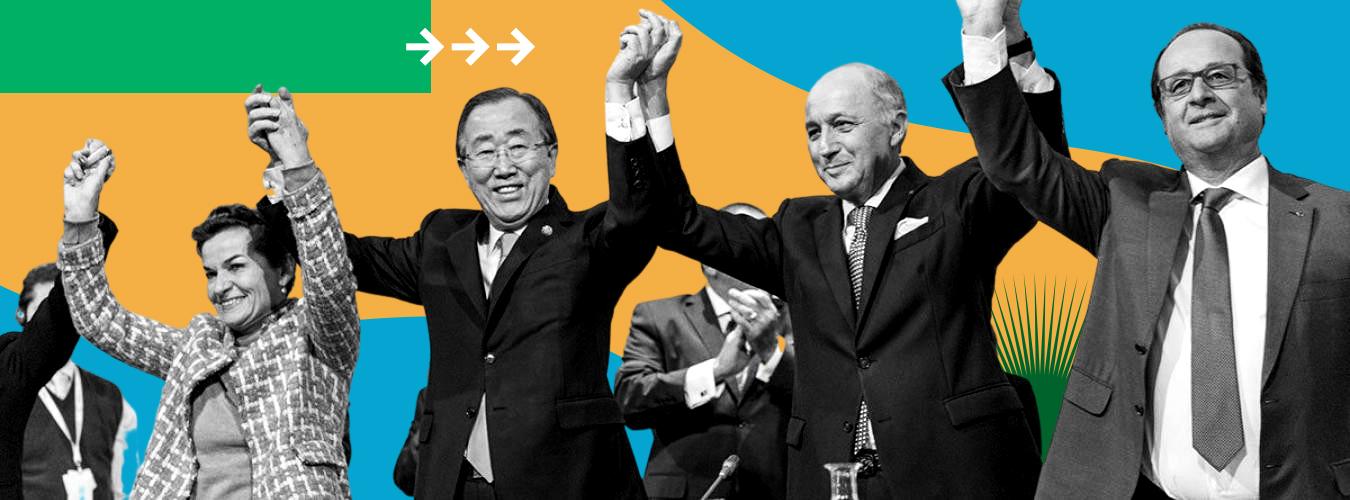The Paris Agreement | United Nations (original) (raw)

Christiana Figueres, Executive Secretary of the UN Framework Convention on Climate Change; UN Secretary-General Ban Ki-moon; Laurent Fabius, Minister for Foreign Affairs of France and President of the UN Climate Change Conference in Paris (COP21); and François Hollande, President of France celebrate after the historic adoption of Paris Agreement on climate change.
Climate change is a global emergency that goes beyond national borders. It is an issue that requires international cooperation and coordinated solutions at all levels.
To tackle climate change and its negative impacts, world leaders at the UN Climate Change Conference (COP21) in Paris reached a breakthrough on 12 December 2015: the historic Paris Agreement.
The Agreement sets long-term goals to guide all nations to:
- substantially reduce global greenhouse gas emissions to hold global temperature increase to well below 2°C above pre-industrial levels and pursue efforts to limit it to 1.5°C above pre-industrial levels, recognizing that this would significantly reduce the risks and impacts of climate change
- periodically assess the collective progress towards achieving the purpose of this agreement and its long-term goals
- provide financing to developing countries to mitigate climate change, strengthen resilience and enhance abilities to adapt to climate impacts.
The Agreement is a legally binding international treaty. It entered into force on 4 November 2016. Today, 195 Parties (194 States plus the European Union) have joined the Paris Agreement.
The Agreement includes commitments from all countries to reduce their emissions and work together to adapt to the impacts of climate change, and calls on countries to strengthen their commitments over time. The Agreement provides a pathway for developed nations to assist developing nations in their climate mitigation and adaptation efforts while creating a framework for the transparent monitoring and reporting of countries’ climate goals.
The Paris Agreement provides a durable framework guiding the global effort for decades to come. It marks the beginning of a shift towards a net-zero emissions world. Implementation of the Agreement is also essential for the achievement of the Sustainable Development Goals.
How does it work?
The Paris Agreement works on a five- year cycle of increasingly ambitious climate action carried out by countries. Every five years, each country is expected to submit an updated national climate action plan - known as Nationally Determined Contribution, or NDC.
In their NDCs, countries communicate actions they will take to reduce their greenhouse gas emissions in order to reach the goals of the Paris Agreement. Countries also communicate in the NDCs actions they will take to build resilience to adapt to the impacts of rising temperatures.
In 2023, the first “global stocktake” of the world’s efforts under the Paris Agreement concluded at COP28 with a decision on how to accelerate action across all areas – mitigation, adaptation, and finance – by 2030, including a call on governments to speed up the transition away from fossil fuels to renewable energy such as wind and solar power in their next round of climate commitments.
To better frame the efforts towards the long-term goal, the Paris Agreement invites countries to formulate and submit long-term strategies. Unlike NDCs, they are not mandatory.
The operational details for the practical implementation of the Paris Agreement were agreed on at the UN Climate Change Conference (COP24) in Katowice, Poland, in December 2018, in what is colloquially called the Paris Rulebook, and finalized at COP26 in Glasgow, Scotland, in November 2021.
More information on the Paris Agreement can be found here.

Key elements of the
Paris Agreement
- To keep global temperatures well below 2C (3.6F) above pre-industrial times while pursuing means to limit the increase to 1.5C.
- To review countries’ contribution to cutting emissions every five years
- To help poorer nations by providing climate finance to adapt to climate change and switch to renewable energy
Aidan Gallagher: The Paris Agreement Works
What is the 'Paris Agreement', and how does it work?
Read more
Net zero
What is net zero? Why is it important? Our net-zero page explains why we need steep emissions cuts now and what efforts are underway.
Adaptation
What is climate adaptation? Why is it so important for every country? Find out how we can protect lives and livelihoods as the climate changes.

